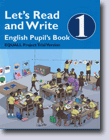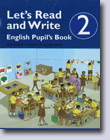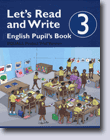Expanding educational opportunities in Ghana: bilingualism and biliteracy for young learners
Biliteracy Curriculum
English in NALAP
Oral language skills form the basis for literacy (Perfetti, 2003). Thus a literacy program requires an oral language component. In a biliteracy program, lessons focus on building oral skills in the pupils’ first language and also teach oral skills in the second (or additional) language. Unless the pupil has developed oral skills in the second language, literacy skills cannot transfer easily.
CAL staff developed a coherent approach to teaching English, Ghana’s official language. In the first year of kindergarten, children develop oral English through reciting rhymes and singing songs, and acting them out. Instead of explaining English words, teachers draw pictures on the chalkboard or use the NALAP conversational posters to provide context for the songs and rhymes. The pictures and the motions help children understand what they are saying or singing. Each unit includes simple pictures for the teacher to draw, a song or rhyme, and actions.
By Primary 3, pupils are reading and writing English as they continue to develop vocabulary and knowledge about the structure of English that the Literacy Standards and Milestones specify.
Experimental English Pupil Books
CAL staff developed pupil books for use in the English lessons and modified the teacher guides to align with them. These books and guides are being used experimentally. The pupil book for Primary 1 English includes illustrations for use in vocabulary development activities, but no text. Those for Primary 2 and Primary 3 include extended text, instructional activities, and plenty of illustrations prepared in Ghana to support comprehension and vocabulary learning.
For more information, view the other components of NALAP:






